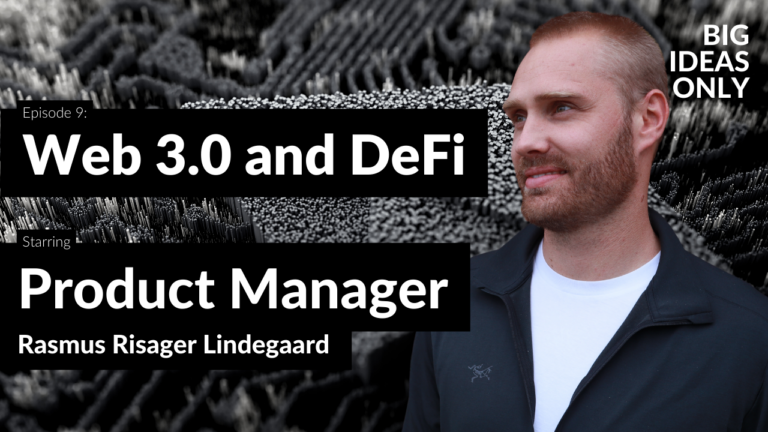
Most people are aware that we, as a society, are facing major environmental challenges. Issues such as global warming, air pollution, and waste are increasingly getting more attention in mainstream media.
Furthermore, we are on the brink of an agricultural revolution.
In this article, we are going to talk about one of the sectors that must transform in the near future: agriculture.
To answer questions on this topic, we asked Lars Horsholt Jensen, the Chief Commercial Officer at Food & Bio Cluster in Denmark, to come into our studio for a talk.
At the beginning of the interview, he talked about the tremendous challenges we face globally in producing enough food to feed the ever-increasing global population.
Let’s get into it.
Agriculture Must Transform
When we consider the question of how to feed more and more people, agricultural transformation is one huge concern. The second big challenge is to do it in a way that is sustainable for the world that we all live in, while considering the influence the food and bio resource industry has on our climate.
It is true that there are tremendous obstacles, but also great ideas being developed. We are looking at an area that will fully change in the next few years and must entirely shift in the coming years.
Your initial intuitive thought might be: “How do we produce more food? How do we maximize yields to feed all these people?”
But as Lars Horsholt Jensen puts it: “It is not really about that.”
To mitigate climate change and create the necessary innovations, we need to think about more than just linear innovation.
It is not simply more of the same; not just more production. It’s also about whole new methods of working and completely new ways of generating food and feed for the nourishment of humans and animals. We have to think about the fact that we’re confronting a climate crisis, an environmental crisis, and a biodiversity crisis all at the same time as the world’s population grows.
Just maximizing yields is no longer the answer.
We’re already very good at increasing yields. That’s exactly what we’ve done.
Recommended Reading
We’ve gone from 60% of the population producing food in the past, to only 2% of the population directly involved in agriculture today. That is an insane improvement in productivity.
- Lars Horsholt Jensen
So, how do we transform that in a different way? Of course, one of the answers is that we need to grow something different in the fields.
According to Lars Horsholt Jensen, we must grow more food for humans and less for animals. That is one of the solutions.
But why exactly is growing plants for people a better idea?
Plant vs. Animal Food: Who Wins?
Denmark relies greatly on animal production. More or less, we acquire our food from animals.
It’s just the truth that 80% of the crops we grow are for animal feed. So, in essence, the farm is generating something that will feed the animals who will then nourish us.
The problem, however, is that animals are not the most effective at converting input into output.
A lot of nutritional potential simply gets wasted.
With cows, for example, only 3% of the feed and calories they consume actually get converted into usable food. The rest is lost.
Don’t get me wrong. No one is claiming that we should all go vegan in order to save the earth, at least not in the eyes of Lars Horsholt Jensen.
Instead, we have to make it clear that animal protein is not the same as plant protein. There are certain amino acids we need for nutritional purposes that you can only get from animal foods.
One of the things that happens when you transition to a plant-based diet is that you naturally receive more carbohydrates than protein, because the mixture in plant food simply contains more carbohydrates.
That is not necessarily what is needed in a Western diet. You need the proteins, but you also get a lot you don’t necessarily need.
It is a fact that eating plants directly is a much more efficient way of nourishing the world. On the other hand, animal foods are a necessary component of a healthy diet. How do you find the right balance between eating the right nutrients and considering the impact on the climate?
- Lars Horsholt Jensen
Growing more food for people means concentrating on protein sources that can be used as both food for humans and feed for animals, such as beans or peas.
Sounds simple enough, but there are other issues that arise from our agricultural practices.
Because what we’re really doing right now is creating a carbon debt and a nutritional debt in the soil that we’re working on.
What Is the Solution for Decreasing Land Fertility?
The soil itself is the greatest asset in agriculture.
That is why innovations in regenerative practices focus on finding ways to replenish the fertility of the earth.
As we mentioned previously, right now we are in debt to the soil.
We take nutrients out and do not return them. This depletes its potential, overtime reducing yields, and eventually can lead to the soil becoming unsuitable for farming.
Fortunately, remedies are being created. That essentially means using the land in a way that minimizes debt while also building up a surplus of nutrients and carbon, particularly, in the soil.
To begin with, there are several agricultural management methods. There are ways to accomplish this. One way is with a plant that can take in nutrients from the air and then transmit it back into the soil when it is plowed.
There are also methods such as pyrolysis that are now being discussed. But what exactly is pyrolysis?
That is essentially burning residues at high temperatures and low oxygen levels. So, it’s actually burning manure fibers and plant waste. That creates biochar, which is a small carbon brick that retains the carbon so that it doesn’t get released into the air to create pollution, but instead slowly returns carbon to the soil.
So, by distributing it across agricultural fields, returning it to the soil over time, you accumulate carbon.
You capture carbon and store it there, then gradually build up carbon reserves in the soil. That is one of the technologies under consideration.
Other solutions entail looking elsewhere for our nutrition. (at plants that many people would probably not consider).
There are plants that contain surprising levels of protein but are, unfortunately, not digestible by humans in their natural form.
Luckily, there is a way to overcome this issue.
Biorefining: Accessing the Inaccessible Proteins
What does it mean when we say that plants with proteins are not digestible by humans?
Let me use grass from your own backyard as an example. Grass grows exceptionally well in the Danish and other northern European climates. But not many people really think of it as an agricultural crop.
It can take as much fertilizer and nutrients as you are willing to give it, more or less, which implies no leakage into the water system (or, at least, considerably less leakage than grains).
Grass is the most successful crop on the globe, as it can be found everywhere. Everyone is aware of it. It’s all over.
It survives, and thrives, in a variety of different conditions and it has a lot of protein in it. Grass contains between 18 and 20% protein, depending on the kind.
Comparatively, a wheat crop contains 8 to 9%, depending on fertilization and other factors. That is almost unbelievable, considering that grass is everywhere. Just for comparison, chicken meat has roughly 27% protein.
That is food for thought.
However, the problem is that mostly just cows can ingest it, digest it, and obtain the proteins.
So, when we talk about biorefining, we’re really talking about separating that protein so that it becomes an accessible form.
- Lars Horsholt Jensen
A grass field has about two and a half times the protein of a wheat feed crop. So, it’s all about making it available to humans and monogastrics.
Looking at how we produce those sorts of crops, how we use those types of crops to feed both humans and animals, is a significant answer to our challenges.
In the first instance, when we speak about grass protein, it can feed animals, but it may also become a greater component of the human diet in the long run.
We’ve arrived at the point where grass protein is being generated on a commercial basis. It is available. It is now being added to animal feed formulations. The Food & Bio Cluster of Denmark is looking into that as part of the solution.
Who would have thought that a potential solution to the environmental crisis, at least from an agricultural perspective, is already growing all around us?
So, in the next few years, farming as we know it will change drastically. This comprises a greater mix of plant and animal nutrition sources, innovative agricultural and farm management strategies, and whole new crops and ways of utilizing existing farmlands.
Lars Horsholt Jensen brought us up to speed on numerous more exciting breakthroughs and ideas that are being created right now. Many intriguing opinions and facts that, sadly, did not make it into this article.
If you are interested learning more about the future of farming, we suggest listening to our podcast Big Ideas Only.














